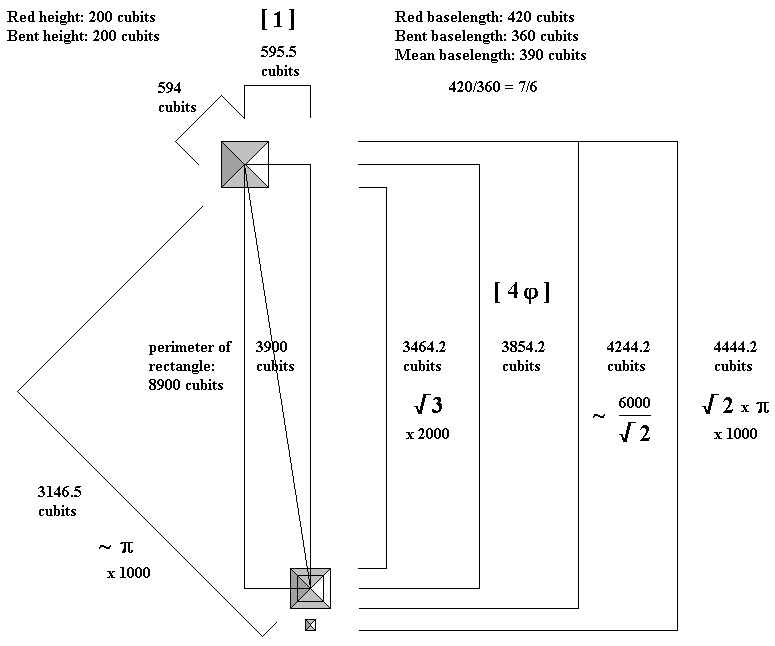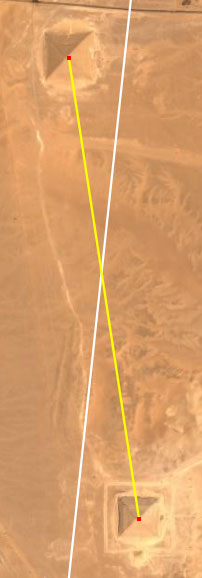DASHUR SITEPLAN
One of the objections raised against a siteplan for the three main pyramids at Giza is that the Giza pyramids are believed to have been built by three different pharoahs, and the conventional view is that the sizes, shapes and locations of the pyramids of successive pharoahs were essentially unrelated to those of their predecessors. At Dashur, the north (Red) pyramid, the south (Bent) pyramid, and the satellite pyramid south of the Bent are all believed to have been built by Sneferu. Thus, at Dashur, the multi-generational objection does not apply. It has been observed that the height of the two main pyramids at Dashur have a direct relationship of 200 cubits each, although the exact intended height of the Red is disputed. Given a baselength of 420 cubits for the Red and 360 cubits for the Bent, the ratio between the baselengths is 7/6, the same as the ratio between the ancient Egyptian common cubit and the royal cubit, although the exact intended baselength of the Bent is also disputed.
In A Season in Egypt (1887), W. M. F. Petrie conducted a survey of the Fayum Road. For his survey he used the summit of the Red and the summit of the Bent as waypoints. He gives the distance between the summits as 6702 feet and the azimuth from the summit of the Red to the summit of the Bent as 171.216°. The text of A Season in Egypt and the page that gives Petrie's measures between the Red and the Bent is available on Ronald Birdsall's website. The apex of the Bent satellite pyramid is due south of the apex of the Bent. The baselength of the satellite pyramid is 100 cubits and the north side of the satellite pyramid is 100 cubits south of the south side of the Bent. Based on the royal cubit of 20.62 inches, 6702 feet converts to 3900.3 cubits. With baselengths of 420 and 360 cubits for the Red and the Bent, the mean baselength for the two is 390 cubits and the distance between the two summits is 10 times the mean baselength of the two pyramids. Based on the azimuth of the line from the summit of the Red to the summit of the Bent, the east-west distance between the two summits is 595.5 cubits:
180° minus 171.216° equals 8.784°.
The sine of 8.784° is .1527
.1527 times 3900 cubits equals 595.5 cubits.
The north south distance between the two summits is
3854.2 cubits:
The cosine of 8.784° is .98827
.98827 times 3900 cubits is 3854.2 cubits.
The ratio between the north-south and the east-west
distance is precisely 4 phi / one:
595.5 x 1.6180339 x 4 = 3854.2

The perimeter of the NS - EW rectangle formed by the
summits of the Red and the Bent is:
595.5 x 2 plus 3854.2 x 2 = 8900 cubits, 5000 cubits more than the distance
between the summits.
The north-south distance between the south side of
the Red and the
north side of the Bent equals the square root of three times 2000 cubits:
3854.2 minus 210 minus 180 = 3464.2
3464.2 divided by 2 = 1732.1
At Giza, the north-south distance between the north side of the
great pyramid and the south side of the third pyramid is 1732 cubits
The north-south distance between the north side of
the Red and the south side
of the Bent satellite pyramid equals the square root of two times pi times
1000 cubits:
3854.2 + 210 + 180 + 100 + 100 = 4444.2
4444.2/1.4142 = 3142
The EW distance between the summits very nearly equals the diagonal baselength of the Red.
The 45° diagonal distance between the summits very nearly equals pi times 1000 cubits. The 4244 cubit NS distance from the north side of the Red to the south side of the Bent times the square root of two is very nearly 6000 cubits. A diagonal rectangle with opposite corners at the north-east corner of the Red and the south-west corner of the Bent has a perimeter of 12,000 cubits. 12,000 cubits is the length of the schoenus - an ancient Egyptian geographic measurement unit. The length of one half of the diagonal rectangle is 6000 cubits. The long side of the diagonal rectangle is approximately pi x 1000 cubits. The ratio between the long side plus the short side over the long side is 6/pi. The baselength over the baselength minus the height of the Red is also 6/pi. At Giza, the 45° diagonal distance from the apex of the great pyramid to the apex of the third pyramid over the diagonal distance from the apex of the great pyramid to the apex of the second pyramid is also 6/pi. A 45° diagonal rectangle with opposite corners on north-east corner of the Red and the south-east corner of the Bent also has a perimeter of 12,000 cubits. The length of the short sides of this rectangle are 2600 cubits and the length of the long sides are 3400 cubits.
Below is a Google earth satellite image of the Red and the Bent. The yellow line connects the apexes of the Red and the Bent. The white line connects the apexes of the Step Pyramid at Saqqara and the Meidum Pyramid. The white line appears to divide the the yellow line into 6/13 to the north of the intersection and 7/13 to the south of the intersection. Prior to building the pyramids at Dashur, Sneferu is believed to have built the pyramid at Meidum. Djoser's Step pyramid at Saqqara was the first major stone pyramid built in Egypt. At the time the Red and the Bent were built, these were the only four major pyramids in Egypt.

The image below shows all of the line from the Meidum Pyramid to the Step Pyramid:

The distance from Meidum to Saqqara is 33.4 miles and the distance from Meidum to the intersection of the line connecting the Dashur pyramid apexes is 28.6 miles. This is approximately 6/7 of the total distance, the distance from Dashur to the Step Pyramid being the other 1/7 of the total distance. This is akin to the ratio of 6/7 between the baselengths of the Bent and the Red. The line from the Meidum pyramid to the Step pyramid is approximately aligned with the orientation of the Step Pyramid and the Step Pyramid complex. The distance from the apex of the Red to the apex of the Bent is approximately 1/4 of the distance from Dashur to Saqqara. The ancient Egyptian royal cubit was divided into seven palms and each palm was divided into four fingers. If the distance from Meidum to Saqqara represented one cubit, the distance from Dashur to Saqqara would be one palm, and the distance from the apex of the Red to the apex of the Bent would be one finger.
Like the pyramids at Giza and the Meidum pyramid, the Red and the Bent are believed to have been cased in Tura limestone blocks that were quarried on the other side of the Nile. In Egyptian Pyramid Geometry (1998) Hadyn Butler gives the haulage distance of 1600 meters from the Nile for Tura limestone that cased the Red and the Bent, as opposed to 400 meters from the Nile for Giza and 230 meters from the Nile for Meidum. In The Pyramids of Egypt (1986 - Revised edition) I. E. S. Edwards also comments on the long overland distance from the Nile to the Dashur pyramids. This would have been necessary to achieve the relationship diagramed above, but the location of the Dashur pyramids, so far from the Nile, is contrary to the conventional explanation that the pyramids were simply built at convenient locations on the west side of the Nile, unrelated to the locations of other pyramids.